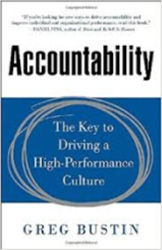April 2015: In This Issue
Welcome to the April 2015 edition of A New Leaf! Many leaders have recently completed the first quarter and may be confronted with shortfalls from their original goals. A high performance culture of accountability will be a critical component of getting their organization back on plan.
This month’s book review focuses on Greg Bustin’s “Accountability-The Key to Driving a High Performance Culture”. This research based reading defines a comprehensive model for building a culture that consistently delivers superior results. Personal and organizational accountability lie at the heart of that culture.
Best of luck as you work to improve your culture through enhanced accountability at all levels. Your employees are ready to embrace clarity in their roles and goals. As a leader, it is your responsibility to make sure these are well defined. Your 2015 results and ultimate organizational sustainability depend upon it!
- Mike

Book Review: “Accountability-The Key to Driving a High-Performance Culture”
Greg Bustin, renowned business consultant and speaker, dedicated over five years to surveying 3,000+ executives to understand the characteristics of a high performance culture. His research addressed one of the biggest issues facing all businesses: successfully achieving their goals by getting from point A to point B. He concludes that the bridge between these points lies in Strategy, Execution and Culture. Accountability is a common component of each of these critical concepts. Without it, the likelihood of any leader getting to point B is greatly diminished.
Bustin defines “accountability” as “doing what you said you would do within the time frame you agreed to do it”. For this to happen, team members must first have clarity as to where they are going and faith in those leading them. High performance is directly related to having the basic trust that people will live up to their promises.
Achieving high degrees of clarity and trust requires leaders facing the stark realization that “we get the behavior we tolerate”. Bustin notes that “leaders are often their own worst enemies in establishing a culture of high performance. Instead of dealing directly with performance issues, they may often go to great extremes to avoid it. As a means of overcoming this leadership avoidance tendency, Bustin sets forth the following lessons:
- Establish clear expectations-When you clearly define what you expect, your employees will embrace the desire to be successful. The opposite is also true: if you are not clear about everything-vision, values, objectives, strategy, rewards and consequences, the likelihood of achieving your results is slim.
- Bad news does not improve with age-When leaders fail to timely address poor performance or other issues, they are accepting that nothing will change. As soon as you see a problem, it is your leadership responsibility to address it immediately.
- It’s not personal-When dealing with performance issues, leaders must leave emotions and opinions behind. Work hard to stick to the facts, set a plan to get performance on track and communicate consequences for underperformance. If poor performers require termination, do it professionally and allow them to exit with their dignity.
In addition to the above lessons, Bustin cautions that before leaders can hold others accountable, they must first hold themselves accountable. He challenges all leaders to answer the questions of “Who am I” and “What do I want” as a means of assessing what matters most to you. Then get on to finding your sweet spot by “doing what you love with people and in a place you care about”.
Once a leader is able to hold themselves accountable, the role of cutting through the continuing circle of excuses from others as to why things are not getting done is much easier. Talk is cheap. Address, don’t’ avoid, excuses from your team.
Bustin also believes establishing the leader’s vision and the Company’s purpose are critical in reaching point B. Leaders must effectively communicate to their team why their vision is both necessary and possible. The team must not only share the vision, they need to believe it. Anything short of complete buy in will significantly diminish the level of employee commitment.
Once a leader has been successful in establishing commitment from his team, Bustin introduces the following “Seven Pillars”, summarized by the acronym of C.U.L.T.U.R.E., as a model to establish and maintain the accountability necessary for high levels of performance:
- Character-as shaped by the company’s values which need to be clearly defined and communicated throughout the organization
- Unity-as characterized by every employee understanding and supporting the organization’s mission, vision, values and strategy and knowing their role in achieving them
- Learning-as reflected by the organization’s commitment to continuous training and development
- Tracking-as indicated by the company’s ability to reliably and accurately measure those things that are most important
- Urgency-as demonstrated by the organization’s practice of making and acting on decisions with a sense of purpose, commitment and immediacy
- Reputation-as measured by how the organization rewards achievement and addresses underperformance, earning the organization and its leaders a following, both internally and externally, as a place where behavior matches its values
- Evolving-as evidenced by the organization’s continuous adapting and changing its practices to advance its market leading position
Bustin dedicates a chapter to each of the core Seven Pillars. Following are highlights from his chapter on the first Pillar of Character.
Character arises from a company’s values being clearly defined and communicated. It is who the company is and what it stands for. All employee decisions are made consistent with the values, even when it is difficult. Answering the following key questions is offered as a means of providing clarity of Character to all employees:
- What is our history and values?
- What is our mission?
- What do we do best?
- Why should people buy from us?
- What is our personality?
- How will we deliver on our promises?
- Who is our best customer and why?
In clarifying Character, Bustin encourages leaders to find the root causes of underperformance, most often found in their people or processes. As to people, he offers that “talent predicts future success. Hire for values as much as skills”. Most often the answer to the question of “could this have been prevented” by someone is yes. Address what needs to be done to minimize the possibility of it happening again. He does not hesitate to caution that to the extent a leader’s “actions do not change the people’s behavior, then you need to change the people”.
In closing his chapter on Character, Bustin shares that the enemy of underperformance is rarely the external competition. Build a successful culture and your Character challenges will significantly decrease.
Getting from point A to point B requires the consistent commitment of the leader and his team to each of the Seven Pillars of Accountability. Like most aspects of any culture, Bustin points out that the Pillars rely on the behavior of your team. High performing teams effectively deal with the need for change. It is an inherent part of every business. Leaders must be prepared to critically look at and challenge all practices as a means of improving their organization. A leader’s ability to leverage change, their willingness to evolve and their conviction to execution will ultimately drive the performance of their organization. Bustin discusses the following reasons why teams find change so difficult:
- People are giving up one thing for another
- It is often prompted by pain
- Things usually get worse before they get better
As part of the change process, Bustin offers the following phrases leaders should never say:
- We have always done it this way
- We’ve never done it that way
Neither of the above phrases is relevant to establishing the clarity that is necessary to get to point B. If the current way of doing things is not getting you there, change it.
In your leadership role, how are you doing in embracing the Seven Pillar concepts? Bustin’s ”Accountability” offers tools and direction for a candid assessment of where you stand and how to improve. If you are committed to a culture of high performance, the Seven Pillars provides a defined path for you to begin to make strides to becoming the best organization you can be.
©2013 See Change Management. All Rights Reserved. Site credit


